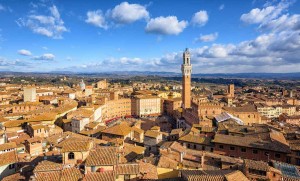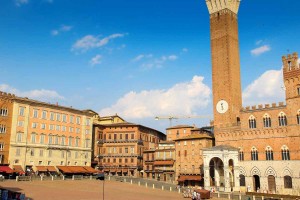
©Bigstock.com/Boris Stroujko
Florence or Siena? Not only tourists ask themselves this question, as there has been a lively artistic and political rivalry between the two cities in Tuscany for many centuries. However, there are clear differences in terms of architecture. While Florence is the epitome of Renaissance charm, Siena is almost entirely about Italian Gothic architecture with medieval elements. It is home to one of the country’s oldest universities, one of the most famous horse races in the world and a particularly beautiful UNESCO World Heritage Site. The historic centre received this honour in 1995 still capturing the imagination of guests from all around the world. Wondering why? Want to know Siena’s absolute must-sees? We might just have the answer to all of that and more.
Siena then and now
While Siena’s actual history might only start in medieval times, the city roots date back much further. It was likely founded by the Etruscans, who named it “Saena”, before becoming a Roman colonia and eventually starting its long and steady rise to power under Langobardic rule. Expanding its influence and territory in the Middle Ages resulted in a long-standing conflict between Siena und Florence on many different levels, which caused constant unrest and even a few brief wars followed by reconciliation periods.
The Republic of Siena would last an impressive 400 years – an era marked by constant domestic political upheavals and numerous conflicts with Naples and the papacy among others. The Black Death of 1348 and poor financial investments only contributed to the unrest, but it wasn’t until 1555 that Siena eventually had to surrender to an alliance of Spain and the Duchy of Florence. The entire territory became part of the Grand Duchy of Tuscany and lost its political power. However, not even wars and bombings could harm Siena’s architectural glory and splendour.
Welcome to the historic centre
170 ha of World Heritage area and another 9,907 ha of buffer zone: The historic centre of Siena is fairly vast. Reaching World Heritage status 13 years after Florence only increased the rivalry between the two cities, yet both most certainly deserve this high honour. Strolling through the historic centre of Siena, you’ll be overwhelmed. The UNESCO calls it the epitome of a medieval city. The Gothic cityscape Siena gained between the 12th and 15th century was persevered beautifully, while the city’s artists and architects would influence colleagues and contemporaries around the globe. You can see and feel this truly special Gothic charm at every corner of the historic centre. Here are only some of our favourites.
Piazza del Campo and the Palio

©Bigstock.com/iryna1
Your city tour starts on Piazza del Campo, Siena’s central and most important square. Its shell-like shape, slight downward slope and the absence of any churches and religious buildings whatsoever make the Piazza unique; a solely political hub between the hills of the city. Countless tourists walk around where markets and fairs used to be held visiting one of the many cafés or pouring into the small, labyrinthine alleys. Fonte Gaia (“Fountain of the World”) on the northwest edge of the square marks the decades of constant endeavours of bringing a stable supply of water to the city. It ultimately took a 25-km-long pipe to succeed. The figurines, which have since been replaced by replicas, mark a decisive step forward in the development of early Renaissance sculpture.
Another thing making Piazza del Campo world-famous is a special horse race. The Palio takes place twice a year – on July 2nd (Palio di Provenzano) and August 16th (Palio dell’Assunta) – entering the 17 contrade or wards of Siena, each colourfully outfitted with historical coats of arms, into this race. Horses are ridden bareback three times around the square in less than two minutes. The celebrations in the winning contrada usually last for weeks.
Palazzo Pubblico
The old seat of Siena’s government, Palazzo Pubblico, was built in 1297 to highlight Piazza del Campo’s role as the centre of political power. The imposing façade – parts natural stone, parts brick masonry – was extended and saw additional storeys added over the course of several centuries. However, the real eyecatcher is the palace tower Torre del Mangia built from 1325 to 1344. It had to be particularly high in other to rise above the cityscape in the dip between the hills, and it became just that.
The splendid, gloriously dimensioned halls inside the palace will wow you. The Great Council Hall (Sala del Mappamondo) got its original name from a sadly lost map of the world by Ambrogio Lorenzetti. Martini’s world-famous frescoes depict the enthroned Madonna and the Condottiere Guidoriccio da Fogliano. The Hall of Nine (Sala della Pace) features an awe-inspiring, allegoric series of frescoes by Lorenzetti widely regarded as a key work of European art due to the revolutionary spatial character depictions and early humanist nature.
Siena Cathedral
One of the key masterpieces of Gothic architecture in Italy actually used to be a Romanesque basilica. Most of the nave was kept and given a Gothic vault with a new transept added after 1260. Giovanni Pisano mostly adopted features of Northwest European Gothic architecture – a first in Italy – adding elements of French Gothic cathedral architecture to his figure programme. Unfortunately, the original façade was lost after having been adapted to baroque architecture and consequently returned to Gothic style. As such, we can only guess what Santa Maria Assunta used to look like. Another, bigger building was supposed to be added to the cathedral in order to outrival Florence, but the Black Death, an economic crisis and static issues nixed such attempts leaving only the unfinished façade and the northern side aisle.
The cathedral is well-known for its mosaic floor. Artistic marble boards serve as a backdrop for over 50 fields covering the entire floor. They feature enchanting biblical scenes, allegories and depictions of prophets. The richly adorned vault of the Piccolomini library and the font in the baptistery with early Renaissance charm are other must-sees.
San Domenico
San Domenico, one of Siena’s four basilicas, is situated at the edge of the historic centre, but still inside the city walls (only since 1430). The Dominicans kept things fairly bare when starting constructions in 1226 leaving the brick building’s front rather plain and functional. The chapels, however, are so much more impressive. You’ll find six alone in the transept, and they’re all artfully decorated. Don’t miss out on Cappella di Santa Caterina, impressively designed and adorned by Niccolò Bensi, the underground crypt with crucifixion scenes and the fresco-lined cloister either.
That’s only a small part of the countless highlights you’ll find in the historic centre of Siena. We could go on like this forever – if you have a bit more time at hand, you must visit Santa Maria dei Servi, San Francesco and Museo dell’Opera del Duomo, just to name a few more must-sees. No matter how much time you have at hand for your trip to Tuscany, Siena is always worth a visit!